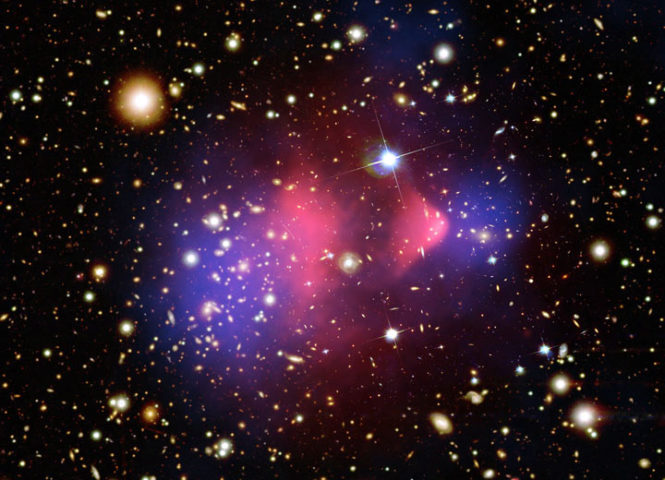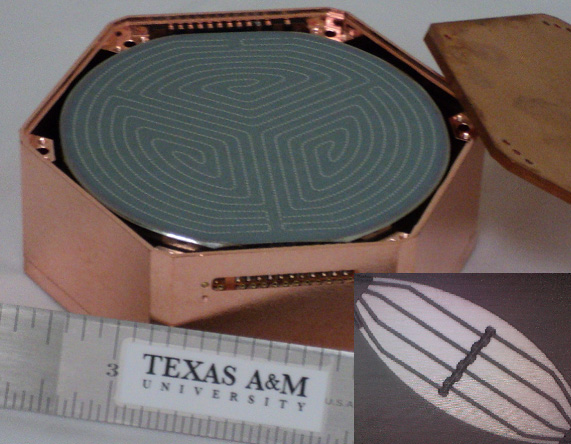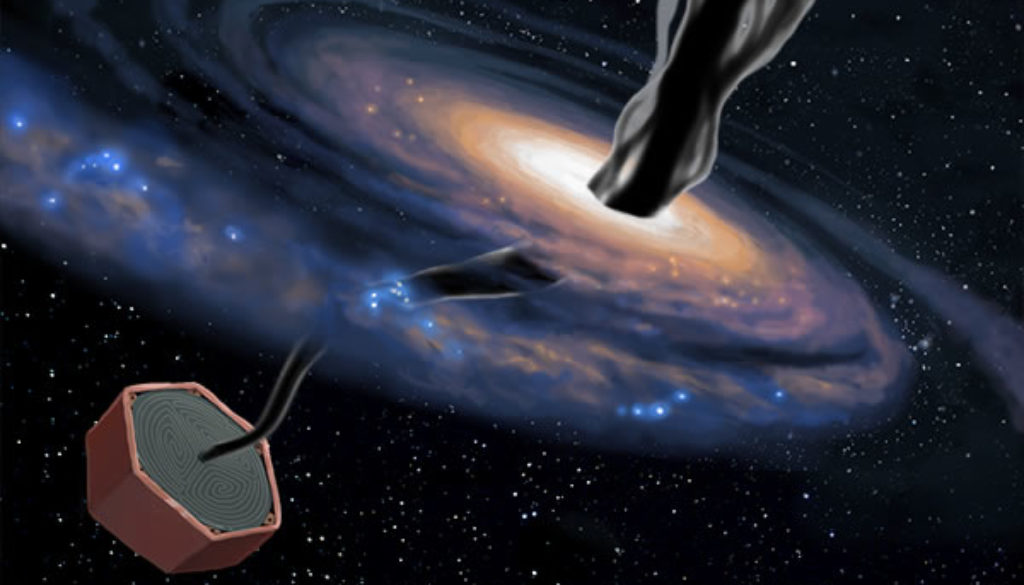Next-Generation Dark Matter Experiments Involving Texas A&M Get Go-Ahead from DOE, NSF
Texas A&M University is involved in two of the three dark matter experiments — including both of the ones searching for weakly interacting dark matter particles — selected for future funding by the U.S. Department of Energy and the National Science Foundation.
On Friday (July 11), the DOE’s Office of Science and NSF’s Physics Division jointly announced they will back the Super Cryogenic Dark Matter Search, or SuperCDMS-SNOLAB experiment; the LUX-Zeplin experiment, or LZ; and the next iteration of the Axion Dark Matter eXperiment, ADMX-Gen2. All three are classified as second-generation dark matter experiments because each will be at least 10 times as sensitive as the current standard in dark matter detection.
Texas A&M scientists are longtime collaborators in the LZ and SuperCDMS experiments, both of which are located underground and searching for WIMPs, or weakly interacting massive particles. ADMX-Gen2 will search for a different kind of dark matter particles called axions.


Texas A&M’s Robert C. Webb, holder of the Ed Rachal Chair in High-Energy Physics, is a principal investigator in LZ, which is based in South Dakota and managed by DOE’s Lawrence Berkeley National Laboratory. In addition, Texas A&M high-energy physicists Rupak Mahapatra and David Toback and condensed matter physicist H. Rusty Harris are principal investigators in SuperCDMS, now situated in Ontario, Canada and managed by another DOE power player, Fermi National Accelerator Laboratory.
“The DOE and NSF have selected the programs best suited to take the hunt for these elusive particles to the next level of sensitivity, and Texas A&M is involved with two of them,” Webb said. “This is a very exciting time for dark matter research, and both teams are hopeful that going to this next level of sensitivity will enhance our chances of discovering these objects.”
Webb and the late Texas A&M physicist James White, were two of the founding members of the Large Underground Xenon (LUX) experiment, which joined forces with the United Kingdom-based ZEPLIN (ZonEd Proportional scintillation in Liquid Noble gases) project shortly after revealing LUX’s first results in October 2013 that established it as the most sensitive dark matter detector in the world.
Selection excitement notwithstanding, the synergistic, multidisciplinary research of two Texas A&M departments, Physics and Astronomy and Electrical & Computer Engineering, is underscored by the collaboration between Mahapatra and Harris (who holds joint appointments in both departments) that is helping to establish Texas A&M and its George P. and Cynthia Woods Mitchell Institute for Fundamental Physics and Astronomy as a driving force as the hunt for dark matter intensifies.
“Dark matter, if discovered, could be the lynchpin between particle physics, astronomy and cosmology and, thus, is at the very center of Mitchell Institute activities,” noted Toback, who joined Mahapatra and Harris as a PI in the experiment last year and brings decades of collider-based research experience at the Fermilab Tevatron. “Indeed, without the institute’s crucial support, the proposals would not been nearly as strong, which is vital in competition. Not every dark matter experiment was selected to move forward, but all the ones in the Mitchell Institute were.”
Program directors from the two federal funding agencies decided which experiments to pursue based on the advice of a panel of outside experts. Both agencies have committed to working to develop the new projects as expeditiously as possible, according to Jim Whitmore, program director for particle astrophysics in the division of physics at NSF.
The funding agencies opted for a varied particle-hunting approach because, although physicists have seen plenty of evidence of the existence of dark matter through its strong gravitational influence, they do not yet know what it looks like as individual particles.
“We wanted to pool limited resources to put together the most optimal unified national dark matter program we could create,” said Michael Salamon, who manages DOE’s dark matter program.
LZ is capable of identifying WIMPs with a wide range of masses, including those much heavier than any particle the Large Hadron Collider at CERN could produce. SuperCDMS, which reported observation of the first concrete hint of WIMPs in 2013, will specialize in looking for light WIMPs with masses lower than 10 GeV [gigaelectronvolts]. (And of course both LZ and SuperCDMS are willing to stretch their boundaries a bit if called upon to double-check one another’s results.)
If a WIMP hits the LZ detector, a high-tech barrel of liquid xenon, it will produce quanta of light, called photons. If a WIMP hits the SuperCDMS detector — a collection of hockey-puck-sized integrated circuits made with silicon or germanium and currently being fabricated at Texas A&M — it will produce quanta of sound, called phonons.
Texas A&M’s SuperCDMS group, which currently features three PIs and is set to add a fourth this fall, is the largest among all collaboration members. Their activities in the experiment span a wide range of technical and scientific aspects, from detector fabrication to cryogenic detector testing, electronics, data acquisition and data analysis.
“We are very excited about the detector technology we are developing and how crucial it is to the success of the low-threshold detectors ideally suited for the low-mass WIMP search,” Mahapatra said. “The large investments from DOE, NSF and the Texas A&M College of Science in our group are finally leading us to play a major role in this world-leading dark matter search experiment.”
Despite the fact that both SuperCDMS and LZ will be located underground, insuring that their detectors will be shielded from cosmic rays and the resulting potential of false positives, they will still need to deal with natural radiation from the decay of uranium and thorium in the rock around them.
To combat this, both experiments collect a second signal, in addition to light or sound — charge. The ratio of the two signals lets them know whether the light or sound came from a dark matter particle or something else. SuperCDMS will be especially skilled at this kind of differentiation, which is why the experiment should excel at searching for hard-to-hear low-mass particles.
“We have been able to apply techniques used in the chip technology sector to vastly improve the quality, cost and throughput of detectors for the CDMS collaboration,” said Harris, who has extensive experience in the semiconductor industry. “In addition, the creative interplay of high-energy particle physics and condensed matter physics has resulted in new, innovative ideas to make detectors that can potentially detect dark matter particles.”
LZ’s strength, on the other hand, stems from its size. Dark matter particles are constantly flowing through the Earth, so their interaction points in a dark matter detector should be distributed evenly throughout. Quanta of radiation, however, can be stopped by much less significant barriers — alpha particles by a piece of paper, beta particles by a sandwich. Even gamma ray particles, which are harder to stop, cannot reach the center of LZ’s 7-ton detector. When a particle with the right characteristics interacts in the center of LZ, scientists will know to get excited.
For more information on the LUX-Zeplin experiment and Webb’s related research, visit Dr. Robert Webb.
To learn more about the SuperCDMS experiment and Texas A&M’s involvement, go to https://physics.tamu.edu/research/high-energy-physics/.
# # # # # # # # # #
About Research at Texas A&M University: As one of the world’s leading research institutions, Texas A&M is in the vanguard in making significant contributions to the storehouse of knowledge, including that of science and technology. Research conducted at Texas A&M represents annual expenditures of more than $820 million. That research creates new knowledge that provides basic, fundamental and applied contributions resulting in many cases in economic benefits to the state, nation and world. To learn more, visit http://research.tamu.edu.
-aTm-
(Story contains excerpts from original that appears in Symmetry Magazine)
Contact: Shana K. Hutchins, (979) 862-1237 or shutchins@science.tamu.edu; Dr. Robert C. Webb, (979) 845-4012 or webb@physics.tamu.edu; or Dr. Rupak Mahapatra, (979) 229-4196 or mahapatra@physics.tamu.edu
The post Next-Generation Dark Matter Experiments Involving Texas A&M Get Go-Ahead from DOE, NSF appeared first on Texas A&M College of Science
